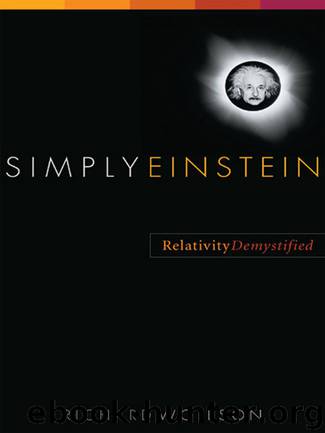Simply Einstein: Relativity Demystified by Wolfson Richard

Author:Wolfson, Richard [Wolfson, Richard]
Language: eng
Format: epub
Publisher: W. W. Norton & Company
Published: 2003-11-17T00:00:00+00:00
Simultaneity Is Relative!
What does it mean to say that two events occur at the same time? If the two events also occur at the same place, then there’s no question. If we see the events simultaneously, then they must have occurred simultaneously. But suppose the events occur at different places. Then an observer watching the two events has to compensate for the time it takes light to get from each event to determine if they were, in fact, simultaneous. You’ve already seen enough of relativity to know that the constancy of the speed of light might make that compensation different for observers in relative motion. So if one observer determines that two events are simultaneous, it becomes an open question whether another observer, moving relative to the first, will deem them simultaneous.
Another approach to determining simultaneity is to set up clocks at the locations of the two events. At each clock, station a reporter who will report to you the time of the event occurring at the location of that clock. If both times are the same, then you can claim that the events were simultaneous. For this to work, you have to be sure those clocks are synchronized. What does that mean? It means both clocks read the same time, say noon, at exactly the same instant. In other words, the event of one clock’s hands pointing to noon is simultaneous with the other clock’s hands pointing to noon. You could synchronize the clocks by standing midway between them and sending a light flash to your reporters at the clocks. Each reporter sets the clock at the instant the light flash arrives. But again we’re back to judging simultaneous events by methods that involve sending light signals through space and, again, relativity leaves open the question of whether observers moving relative to you will agree that the events are simultaneous. In this case, that means such observers might not agree with you that your clocks are synchronized.
In fact, events that are simultaneous in one frame of reference may not be simultaneous in another reference frame. I’m now going to demonstrate this rigorously in a way that follows from the Principle of Relativity. To do so, I’ll invoke relativistic length contraction—a result which, as I showed in the preceding chapter, follows logically from the relativity principle. Recall that an object is longest in a reference frame in which it’s at rest and shorter as measured in any other reference frame. In our earlier examples, one “object” in question was the Earth–star pair, whose separation contracted from 20 light-years in the Earth–star frame to 12 light-years in the ship frame. Another object we considered was Mount Washington, 6,300 feet high in the Earth frame but contracted to only 700 feet in the reference frame of muons for which Mount Washington was moving at 0.995c.
I’m now going to consider two distinct objects and look at how length contraction applies to each of them in different reference frames. The objects are two identical
Download
This site does not store any files on its server. We only index and link to content provided by other sites. Please contact the content providers to delete copyright contents if any and email us, we'll remove relevant links or contents immediately.
The Complete Stick Figure Physics Tutorials by Allen Sarah(7307)
Secrets of Antigravity Propulsion: Tesla, UFOs, and Classified Aerospace Technology by Ph.D. Paul A. Laviolette(5309)
Thing Explainer by Randall Munroe(3877)
The River of Consciousness by Oliver Sacks(3540)
The Order of Time by Carlo Rovelli(3145)
How To by Randall Munroe(3035)
A Brief History of Time by Stephen Hawking(2961)
I Live in the Future & Here's How It Works by Nick Bilton(2935)
The Great Unknown by Marcus du Sautoy(2648)
What If?: Serious Scientific Answers to Absurd Hypothetical Questions by Randall Munroe(2637)
Midnight in Chernobyl by Adam Higginbotham(2483)
Blockchain: Ultimate Step By Step Guide To Understanding Blockchain Technology, Bitcoin Creation, and the future of Money (Novice to Expert) by Keizer Söze(2446)
Networks: An Introduction by Newman Mark(2360)
The Meaning of it All by Richard Feynman(2300)
Easy Electronics by Charles Platt(2281)
The Tao of Physics by Fritjof Capra(2231)
Midnight in Chernobyl: The Untold Story of the World's Greatest Nuclear Disaster by Adam Higginbotham(2177)
When by Daniel H Pink(2083)
Introducing Relativity by Bruce Bassett(2080)
